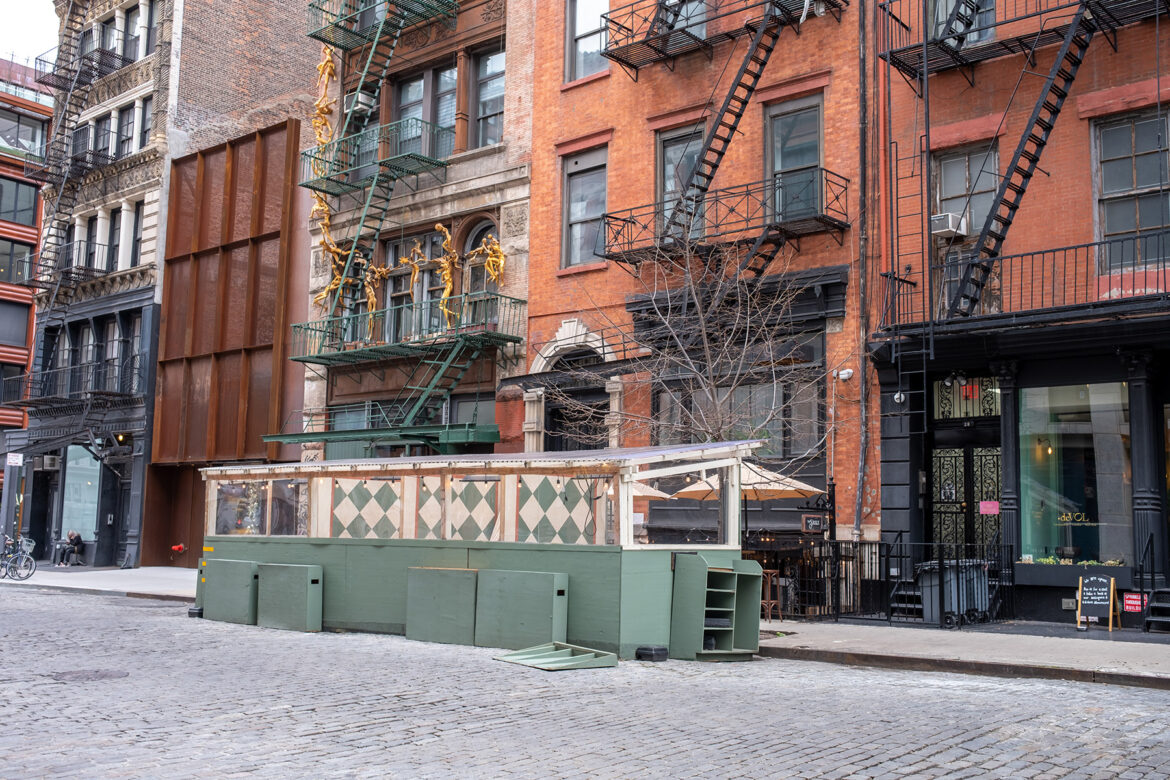In our Spring 2022 issue, Rachael Philipps wrote “The Big Pivot,” an expansive article that discusses the transformed state of New York restaurants two years into the COVID-19 pandemic. There were a lot of elements to that story, but one idea came up over and over: that New York City’s outdoor dining sheds offered a lifeline for both restaurants and cabin feverish diners. Our story was necessarily inconclusive about the future of the sheds. At the time of writing (mid-Omicron winter), NYC had tentatively extended permission for the shed’s street-side existence, but there were no promises for the long term.
RELATED: The Big Pivot: Tales of the New York City Dining Scene Now
If you’re reading this, chances are you’re pretty pro-restaurants, pro-restaurant workers and pro-food in general. Chances are, you appreciated the curbside structures for enabling (in most cases) safer dining during the pandemic. Maybe you realized that these sheds provided, especially in the case of tiny restaurants, the ability to serve significantly more diners during periods of reduced indoor occupancy. Given the setbacks of pre-vaccine 2020, when restaurants were limited to 25-percent occupancy—and frequently closed for good or operated at a loss—the sheds meant that restaurants might earn sustaining revenue. Even post-vaccine and post-Excelsior Pass, when dining rooms once again felt full, the sheds let restaurateurs play revenue catch-up with seating that extended beyond their indoor footprint. Plus, when they were launched, the sheds were fun; it was novel to eat an elegant, hot meal on the street in December.
That said, the sheds have become increasingly problematic. For every glitzy, HEPA-filtered geodesic glam-bubble, there are several shabby lean-tos. Worse, there is a long list of abandoned sheds that were simply left in place when restaurants closed. As Eater reports in this article by Bao Ong, these abandoned sheds become DOT liabilities: “Removing a shed can require a dozen workers, several trucks, and Department of Health employees to deal with any hazardous materials like needles.” There are also problems with sheds becoming structurally unsafe after being abandoned, harboring vermin, or turning into attractive nuisances that encourage arson, rowdiness and vandalism.
Then there are the residents who complain that in the restaurant-dense streets of already-congested Lower Manhattan (like the roughly 500 feet of Cornelia Street, which, at the time this article was written, held nine dining sheds), the structures greatly reduce available street parking—which additionally reduces the city’s Muni Meter and parking ticket revenue. Some shop owners say that the sheds block their businesses from street visibility while narrowed sidewalks create challenges for disabled people. Plus, as the New York Post reports, “Councilman Kalman Yeger (D-Brooklyn)…complained that restaurant owners have ‘been able to increase the size of their space, not pay real property taxes on it, not pay rent on it and have the ability to get free space courtesy of New York City.’”
The upshot of all this is that—as the sheds age, as unforeseen problems crop up, as we become pandemic fatigued and the thrill of them basically wears off—NYC’s dining sheds are very much endangered. In that same New York Post article, Julie Schipper, the DOT’s director of the Open Restaurants program, said that existing shed permissions will not be grandfathered into more permanent permissions, and that all of the sheds will be removed once the pandemic is deemed “over.” While it looks like COVID will be with us for the long haul, and that declaration of “over” might be a way’s off, popular opinion is fomenting against NYC’s once-welcomed sheds.
Gabriel Stulman, CEO and founder of Happy Cooking Hospitality (whose four West Village restaurants include Jeffrey’s Grocery), was quoted in our Spring 2022 article. He is a strong proponent of the dining sheds but feels the city’s ad hoc shed program needs to be substantially reformed and perpetually overseen. Says Stulman of the ways that NYC government can help restaurants, “One of the most important things that government can do is to let outdoor dining stay. Some people complain about parking loss but the Department of Transportation, who’s currently in charge of who gets to use the street, released a report that says it occupies less than 1 percent of the city’s total street parking. Can we do things about some of the sheds that look like trash? Of course we can—and we should. We can make more regulations around what they can and can’t look like, and how long they’re allowed to remain.” For that to happen, the city is looking at a major revision of the dining shed rules by the DOT’s Open Restaurants program. Stay tuned.



